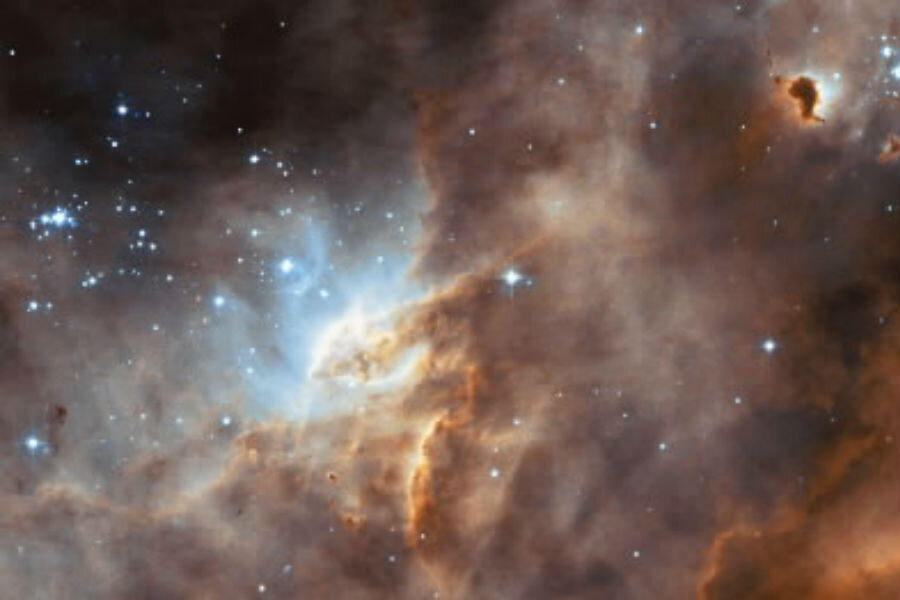Rosetta's new to do: hunt for sugars in comet ice?
Loading...
The European Space Agency's Rosetta mission may have a new set of primordial chemicals to hunt for as the spacecraft scrutinizes 67P/Churyumov-Gerasimenko.
A team of chemists from France and Mexico reports finding what it says is the first evidence for a range of organic molecules known as aldehydes in the residue of lab-made ices. These ices were designed to simulate those found in the clouds of gas, dust, and ices between stars.
Of particular interest are a pair of sugar-like aldehydes found in some of the residue. These aldehydes are known to be important actors in the formation of DNA, which carries an organism's genetic information, and of RNA. RNA plays a number of important biological roles, including service as a genetic traffic cop for the production of proteins in cells.
Six of the 10 aldehydes the team found have been detected in space, including one of the two sugar-like aldehydes. But none of the sugar-like versions have been detected within the solar system, and one of the two has yet to be found at all in space.
The team's results imply that both of these "pre-biotic" molecules, as well as the rest of the aldehydes they produce, should be forming within interstellar ices.
If the results hold up – and especially if Rosetta's robotic lander Philae can detect them on comet 67P/Churyumov-Gerasimenko – the work would provide another piece of evidence pointing to comets and asteroids as the mobile chemistry labs that deposited the building blocks for organic life on a young Earth.
In space, ices form in large molecular clouds from simple molecules – mainly water, with smatterings of carbon monoxide, carbon dioxide, methanol, ammonia, and methane. When the ices are subjected to ultraviolet radiation from young stars and from heat, these building blocks can combine to make biologically important compounds such as amino acids.
The densest portions of these clouds collapse to form stars and planets, as well as the comets and asteroids that represent the leftovers from the era of planet-building.
For years, researchers have been conducting lab experiments that try to replicate the conditions in molecular clouds, bathing the ices in various levels of ultraviolet radiation or the lab equivalent of cosmic rays. The goal is to figure out how much of the pre-biotic chemistry on Earth was unique to the planet and how much "pre-processing" might have occurred in space.
In its experiment, a team led by Louis Le Sergeant d’Hendecourt, with the Institut d’Astrophysique Spatiale at the Université Paris-Sud, and Uwe Meierhenrich, with the Université Nice-Sophia Antipolis in Nice, France, started off with a mixture of 12 parts water, 3.5 parts methanol, and 1 part ammonia. The ice was cooled in a vacuum to -319 degrees Fahrenheit and bathed in ultraviolet light. The experimental equipment had been carefully cleaned and sterilized to prevent contamination.
After ice samples were warmed back to room temperature and the water extracted, the team found the 10 aldehydes, including the two sugar-like versions: glycolaldehyde and glyceraldehyde. Glycolaldehyde has been detected outside the solar system, but not within it. Glyceraldehyde has yet to be seen at all in space, according to the researchers.
Although the team detected 10 aldehydes, the number and type of aldehydes varied among the samples. Interestingly, the two sugar-like aldehydes were mission from the samples that also were missing ammonia.
The aldehydes formed on the surface of ice samples, in a process that would make it easy to capture the aldehydes within a comet or meteoroid as these planet-wannabes scoop up material from the disk of dust and gas surrounding their parent stars.
The next step, the researchers say, is to hunt for the two sugar-based aldehydes in comets (Are you listening, Philae?) and in certain forms of meteorites.
If these efforts succeed, they would support "a scenario in which chemically evolved cosmic ices played a major role in the feeding of organic materials to the primitive solar nebula," the team writes.
The team's findings were published online Monday by the Proceedings of the National Academy of Sciences.








